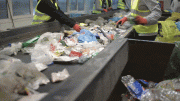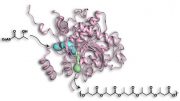
Thermoset polymers, found in car parts and electrical appliances, have to be durable and heat-resistant, but typically cannot be easily recycled or broken down after use. MIT chemists have now developed a way to modify thermoset plastics that allows them to be more easily broken down without compromising their mechanical strength.
New method for producing thermoset plastics allows them to be broken down more easily after use.
Thermosets, which include epoxies, polyurethanes, and rubber used for tires, are found in many products that have to be durable and heat-resistant, such as cars or electrical appliances. One drawback to these materials is that they typically cannot be easily recycled or broken down after use, because the chemical bonds holding them together are stronger than those found in other materials such as thermoplastics.
MIT chemists have now developed a way to modify thermoset plastics with a chemical linker that makes the materials much easier to break down, but still allows them to retain the mechanical strength that makes them so useful.
In a study published in Nature, the researchers showed that they could produce a degradable version of a thermoset plastic called pDCPD, break it down into a powder, and use the powder to create more pDCPD. They also proposed a theoretical model suggesting that their approach could be applicable to a wide range of plastics and other polymers, such as rubber.
“This work unveils a fundamental design principle that we believe is general to any kind of thermoset with this basic architecture,” says Jeremiah Johnson, a professor of chemistry at MIT and the senior author of the study.
Peyton Shieh, an American Cancer Society Postdoctoral Fellow at MIT, is the first author of the paper.
Hard to recycle
Thermosets are one of the two major classes of plastics, along with thermoplastics. Thermoplastics include polyethylene and polypropylene, which are used for plastic bags and other single-use plastics like food wrappers. These materials are made by heating up small pellets of plastic until they melt, then molding them into the desired shape and letting them cool back into a solid.
Thermoplastics, which make up about 75 percent of worldwide plastic production, can be recycled by heating them again until they become liquid, so they can be remolded into a new shape.
Thermoset plastics are made by a similar process, but once they are cooled from a liquid into a solid, it is very difficult to return them to a liquid state. That’s because the bonds that form between the polymer molecules are strong chemical attachments called covalent bonds, which are very difficult to break. When heated, thermoset plastics will typically burn before they can be remolded, Johnson says.
“Once they are set in a given shape, they’re in that shape for their lifetime,” he says. “There is often no easy way to recycle them.”
The MIT team wanted to develop a way to retain the positive attributes of thermoset plastics — their strength and durability — while making them easier to break down after use.
In a paper published last year, with Shieh as the lead author, Johnson’s group reported a way to create degradable polymers for drug delivery, by incorporating a building block, or monomer, containing a silyl ether group. This monomer is randomly distributed throughout the material, and when the material is exposed to acids, bases, or ions such as fluoride, the silyl ether bonds break.
The same type of chemical reaction used to synthesize those polymers is also used to make some thermoset plastics, including polydicyclopentadiene (pDCPD), which is used for body panels in trucks and buses.
Using the same strategy from their 2019 paper, the researchers added silyl ether monomers to the liquid precursors that form pDCPD. They found that if the silyl ether monomer made up between 7.5 and 10 percent of the overall material, pDCPD would retain its mechanical strength but could be broken down into a soluble powder upon exposure to fluoride ions.
“That was the first exciting thing we found,” Johnson says. “We can make pDCPD degradable while not hurting its useful mechanical properties.”
New materials
In the second phase of the study, the researchers tried to reuse the resulting powder to form a new pDCPD material. After dissolving the powder in the precursor solution used to make pDCPD, they were able to make new pDCPD thermosets from the recycled powder.
“That new material has nearly indistinguishable, and in some ways improved, mechanical properties compared to the original material,” Johnson says. “Showing that you can take the degradation products and remake the same thermoset again using the same process is exciting.”
The researchers believe that this general approach could be applied to other types of thermoset chemistry as well. In this study, they showed that using degradable monomers to form the individual strands of the polymers is much more effective than using degradable bonds to “cross-link” the strands together, which has been tried before. They believe that this cleavable strand approach could be used to generate many other kinds of degradable materials.
“This is an exciting advance in engineering thermoset plastics,” says Jeffrey Moore, a professor of chemistry at the University of Illinois, who was not involved in the study. “Chemists have spent most of their effort learning to synthesize better plastics, and far less chemistry research has been invested into the science of polymer deconstruction. Johnson’s work helps to fill this important gap in fundamental knowledge while providing advances of technological significance.”
If the right kinds of degradable monomers can be found for other types of polymerization reactions, this approach could be used to make degradable versions of other thermoset materials such as acrylics, epoxies, silicones, or vulcanized rubber, Johnson says.
The researchers are now hoping to form a company to license and commercialize the technology.
Patrick Casey, a new product consultant at SP Insight and a mentor with MIT’s Deshpande Center for Technological Innovation, has been working with Johnson and Shieh to evaluate the technology, including performing some preliminary economic modeling and secondary market research.
“We have discussed this technology with some leading industry players, who tell us it promises to be good for stakeholders throughout the value chain,” Casey says. “Parts fabricators get a stream of low-cost recycled materials; equipment manufacturers, such as automotive companies, can meet their sustainability objectives; and recyclers get a new revenue stream from thermoset plastics. The consumers see a cost saving, and all of us get a cleaner environment.”
Reference: “Cleavable comonomers enable degradable, recyclable thermoset plastics” by Peyton Shieh, Wenxu Zhang, Keith E. L. Husted, Samantha L. Kristufek, Boya Xiong, David J. Lundberg, Jet Lem, David Veysset, Yuchen Sun, Keith A. Nelson, Desiree L. Plata and Jeremiah A. Johnson, 22 July 2020, Nature.
DOI: 10.1038/s41586-020-2495-2
The research was funded by the National Science Foundation and the National Institutes of Health.









Be the first to comment on "MIT Chemists Make Tough Thermoset Plastics Recyclable"